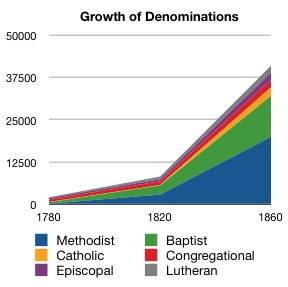
In addition to demographic changes, there also a shift in religious beliefs or lack thereof. The chart below shows the growth in various churched from 1780 to 1860. One will note it is primarily protestants, with Methodists and Baptists dominating. There is a very small line for Catholics. The Catholic areas tended to be where there were Hispanic populations (Texas and California) or where there were Americans of French descent (Louisiana). The state of Maryland was also established as a Catholic colony. During the time of the English Civil War, Catholic Maryland was invaded twice by Virginia, generating one “major” battle (The Battle of Severn in 1655 near what is now Annapolis, Maryland). The Battle of Severn resulted in 2 killed from the 175 Virginian attackers and 49 casualties (17 killed, 32 wounded, with 4 people executed after the battle) among the 130 defenders (38% casualties).

So this takes us up to the U.S. Civil War. The Irish Potato famine started in 1845, generating a large migration of Irish Catholics to the United States. The Irish population declined from around 8.18 million in 1841 to 5.8 million in 1861 and continued to decline to 4.21 million in 1931. The U.S. Irish population boomed. This was followed by many other immigrations from other parts of Europe. By 1950 the split of religions was:
Protestant: 69%
Catholics: 25%
Jewish: 4%
Other religions: 3%
Undesignated: 2%
As of 2017, the same source (Gallup) reports:
Protestant: 38%
Catholics: 21%
Non-denominational Christian: 9%
Mormon: 2%
Jewish: 2%
Other religions: 5% (Muslims make up around 1%)
None: 20%
Undesignated: 4%
Some political parties tend to make religious appeals based on Judeo-Christian heritage, but…it appears that around 30% of the U.S. population no longer identifies itself as Christian. This is a significant change. Most of that change started in the 1970s and greatly expanded in the 1990s and is continuing to expand.
Year……Percent not Christian *
1970……8%
1975…..13%
1980…..11%
1985…..14%
1990…..18%
1995…..18%
2000…..17%
2005…..19%
2010…..24%
2015…..29%
2017…..31%
* i.e. Designated Jewish, Other Religions,. None and Undesignated.
The United States has had two Catholic presidents (Kennedy and Biden), three presidents of significant Irish descent (including Reagan who was half-Irish and half-English/Scottish), two of significant German descent (Eisenhower and Trump **), one of Dutch descent (Van Buren, the only president to speak English as a second language ***), one who was mixed race (Obama), none of Italian descent, none Hispanic, none Jewish and none Mormon. 38 of our 45 Presidents were primarily English/Scottish descent and officially protestants.
** Trump is German on his father’s side and Scottish on his mother’s side.
*** Theodore Roosevelt was 1/4 Dutch.

Nice listing of statistics!
I and other orthodox Christians (not meaning one of the Orthodox Catholic Denominations such as Russian Orthodox and Greek Orthodox and Coptic Orthodox and . . .) would exclude Mormon (LDS) and Catholic (and possibly Orthodox) from Christian. Come to think of it, we’d also exclude large portions of mainline churches that were traditionally identified as Protestant (even though Rick Warren gave a talk at quasi-Catholic, semi-Jesuit Georgetown University during which he said that there are no longer any Protestants, because we aren’t protesting anything with Catholicism being the formerly protested religion to which he was appropriately referring since he was speaking at GU : – )
Alternatively, one could keep those religions plus adding Judaism to constitute the Judeo-Christian cultural category since they have a common mindset about one country under Yahweh (although those of us who are Anabaptist would be less inclined to assume a unique relationship between gentile nations and The Kingdom).
Still, the statistics make the point that the Democratic Party has less and less reason to court Christians (although you might want to also present statistics concerning the religious affiliations of African Americans who do show some decline while still having religious affiliation being an important part of identity).